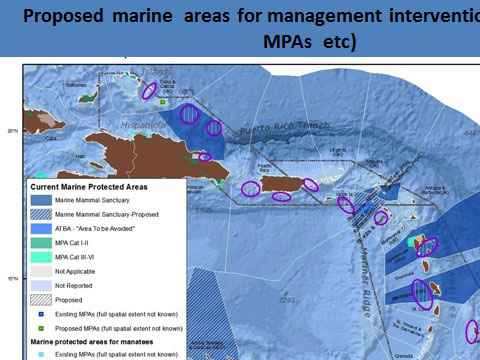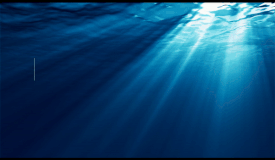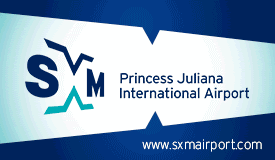 Executive Summary
Executive Summary
The eastern Caribbean is of special significance to regional marine mammal conservation based on its high abundance and diversity of cetaceans. As signatory to both the CBD and the Cartagena Convention, and based on its international commitment to cetacean conservation, the Netherlands is also highly committed to cetacean conservation in the Caribbean, and asked IMARES to represent the ministry of economic Affairs at this meeting.
Using scenario development based on overlap analysis, Marine Spatial Planning (MSP) was demonstrated as useful tool for planning the regional network of protected areas which will be required for integrated long-term management and conservation of wide ranging migratory cetaceans. Several cetacean sanctuaries have already been established or are currently underway in the region as the whale watching industry continues to grow and island nations gradually recognize the economic potential they represent. Several marine areas of key cetacean concern were identified along the Caribbean island arc. Results show that the Windward Dutch Caribbean EEZ (of the Saba Bank, Saba, St. Maarten and St. Eustatius), lies adjacent to two identified marine mammal problem areas and, therefore, emphasizes the special importance of the Windward Dutch Caribbean EEZ to Wider Caribbean marine mammal conservation. This should serve as additional impetus to the Netherlands and Dutch Caribbean islands towards implementation of their ambitions for a Marine Mammal Reserve in this area.
Local importance of any specific area for MSP-based management of wide-ranging species like cetaceans can only be defined in regional context. This means that Caribbean-wide data are also critical at the local level. Hence, it is vital for any national research program to also contain a major component of broader trans-boundary collaboration. The Dutch representatives informed the meeting about several new and valuable cetacean reports and studies, plans, and projects, as well as their continued commitment to collaborate in regional projects. Several key opportunities for knowledge development and participation, as well as knowledge gaps were identified, which can serve as possible focus topics for research.
Introduction
Representatives of the Ministry of Economic Affairs, the St. Maarten Nature Foundation and the Saba Bank Management Unit attended a regional high-level meeting concerned on the management of Marine Mammals and specifically Whales in San Juan, Puerto Rico. The meeting comes directly as follow-up to the Inter-regional Workshop on Broad-Scale Marine Spatial Planning and Trans-boundary Marine Mammal Management, held in Panama City, Panama, 21-24 May 2012. The meeting was opened by the Secretary of Natural Resources and Environment of Puerto Rico, Prof. Carmen R. Guerrero Pérez. The meeting in San Juan was attended by three representatives for the Dutch Caribbean, namely: Jimmy van Rijn, representing the Saba, Tadzio Bervoets, representing the St. Maarten Nature Foundation and Dolfi Debrot, representing the Ministry of Economic Affairs of the Netherlands. The meeting was organized by the Regional Activity Center for Specially Protected Areas and Wildlife (RAC-SPAW), part of United Nations Environmental Program-Caribbean Environmental Program with expenses paid by the Government of Spain through their voluntary contribution to the SPAW program, stemming from their long-term involvement and support for development of Latin America. The manpower for participation of the Dutch Caribbean representatives were jointly covered by the respective park organizations and the Ministry of EZ.
Cetacean conservation in the wider Caribbean and tropical South America has grown greatly in recent decades. Cetacean sanctuaries are being established as the whale watching industry continues to grow and island nations gradually grow to recognized the great economic potential that cetaceans represent within the context of tourism as a primary regional industry. Ambitious new initiatives for the establishment of marine protected areas include several initiatives in Puerto Rico and the British Virgin Islands, a trans-boundary project between Puerto Rico and the USVI, and a multinational tropical Pacific initiative led by the Costa Rican NGO MARVIVA. All parties involved recognised the need to establish a network of linked protected areas conserving key habitat for cetaceans throughout the Caribbean region. This follows from the fact that, without exception, marine mammals represent widely migratory species that make use of widespread areas for different critical functions during the course of their long life cycles.
The Caribbean Netherlands also possess a rich and diverse cetacean fauna, most species of which are either internationally endangered or protected, or both. Consequently, their conservation and collection of key biological information from these poorly known species is a major priority for the Netherlands, not only in the Dutch Caribbean but also in European and international context. IMARES is the key agency providing the government of The Netherlands with policy advice on marine mammal issues in Europe, world-wide and including the Caribbean. Marine mammals form a major topic of concern in the Nature Policy Plan and the EEZ management plan developed by the Ministry for the Caribbean Netherlands. Since 2010, the Netherlands has assumed a leading role in cetacean conservation and research in the region and following the lead of the nearby Dominican Republic and France, the government of the Netherlands and her island partners are looking to install a large Marine Mammal Reserve in the Caribbean, probably by the end of 2014. Dutch involvement is greatly appreciated particularly by the French and the USA, as it greatly reinforces their own independent conservation and research initiatives.
The overall goal of the meetings on Scenarios for trans-boundary marine mammal management in the Wider Caribbean is to assist implementation of the Convention on Biological Diversity Programme of Work on Protected Areas. The project also directly supports implementation of Marine Mammal Action Plans of the Regional Conventions of UNEP´s Regional Seas Programmes for the Wider Caribbean (Cartagena Convention) and the Southeast Pacific (Lima Convention). The involvement of The Netherlands follows forth from the fact that it is signatory to the Cartagena Convention which is the main legal framework for implementation of the CBD convention goals in the marine environment of the Caribbean.
In the 2012 meeting, the eastern Caribbean island chain, of which St. Maarten, Saba and St. Eustatius form part, were identified as a key region of priority due its exceptional regional concentration and diversity of cetaceans. During the 2014 meeting a new Marine Spatial Planning (MSP) approach was presented and initial modelling results based on 2 years of research were discussed and evaluated.
Key conclusions were that using the MSP approach of overlap analysis several marine areas of key cetacean concern were identified. These were a sequence of areas stretching along the island chain from Turks and Caicos south to Barbados and Grenada (see figure). Local importance of any specific area for wide-ranging species can only be defined in regional context. This means that Caribbean Wide data are of key importance at the local level. Such information can only be obtained through joint cooperative projects. Hence, it is critical for any national research program should contain a major component of international collaboration. The meeting concludes that protecting whales forces humans to collaborate across national boundaries.
In each indicated area cetaceans face a variety of different problems. Consequently each area will require requires additional scientific study as well as tailored measures to be implemented on initiative of the respective governments. While much work is needed to refine and perfect for implementation of diverse measures, the key observation most pertinent to the Netherlands is that the modelling results indicate the Dutch Caribbean EEZ surrounding the Saba Bank, Saba, St. Maarten and St. Eustatius lies adjacent to two marine mammal problem areas (based on human use pressures...USVI and St. Kitts/Nevis) (see figure).
Therefore, the results emphasize the special importance of the Windward Dutch Caribbean EEZ zone within the wider Caribbean marine mammal context. Hopefully this can serve as additional impetus to the Netherlands and Dutch Caribbean islands for a timely implementation of their ambitions for a Marine Mammal Reserve in that area.
A full report with recommendations is from the meeting is forthcoming.
During the meeting the Dutch Caribbean representatives informed the meeting participants about:
- the successful engagement of industry sectors (particularly fishermen harbour works and dive sector) in joint management and research on cetaceans. In this, the Dutch Caribbean can serve an excellent example to others who generally find involvement of other sectors to be very difficult.
- Several new knowledge products (papers and reports), which were made available to the group
- Dutch Caribbean interest and commitment to support several ongoing joint initiatives as funding and manpower permit (AGOA surveys and MEGARA satellite tagging with the French)
- Dutch Caribbean commitment to the use and development of acoustic approaches to help standardize economic data gathering across larger spatial scales.
- At the same time, commitment to support collection and reporting of opportunistic data (sightings and strandings) as supported a wide cross section of amateur stakeholders.
Key new opportunities for knowledge, and participation in research and awareness were:
- A noise mapping project for the Caribbean to be led by NOAA
- A humpback tail ID project to be led by NOAA
- A regional "Jump with the whales" awareness campaign publicity campaign to be led by UNEP
- Maps of human pressures available from SPAW-RAC
- Ship strike conference in June in Panama... IWC/SPAW...proceedings
- SPAW COP8, November 2014
- Lobby opportunity at the Florida & Caribbean Cruise Ship Ass. Meeting (6-10 Oct) in St. Maarten
- Initial MEGARA tagging results showing that the island breeding humpback whales are fully shared between island and that they migrate to areas of the eastern and western north Atlantic
- A large number of knowledge gaps to serve as possible focus topics for research.













